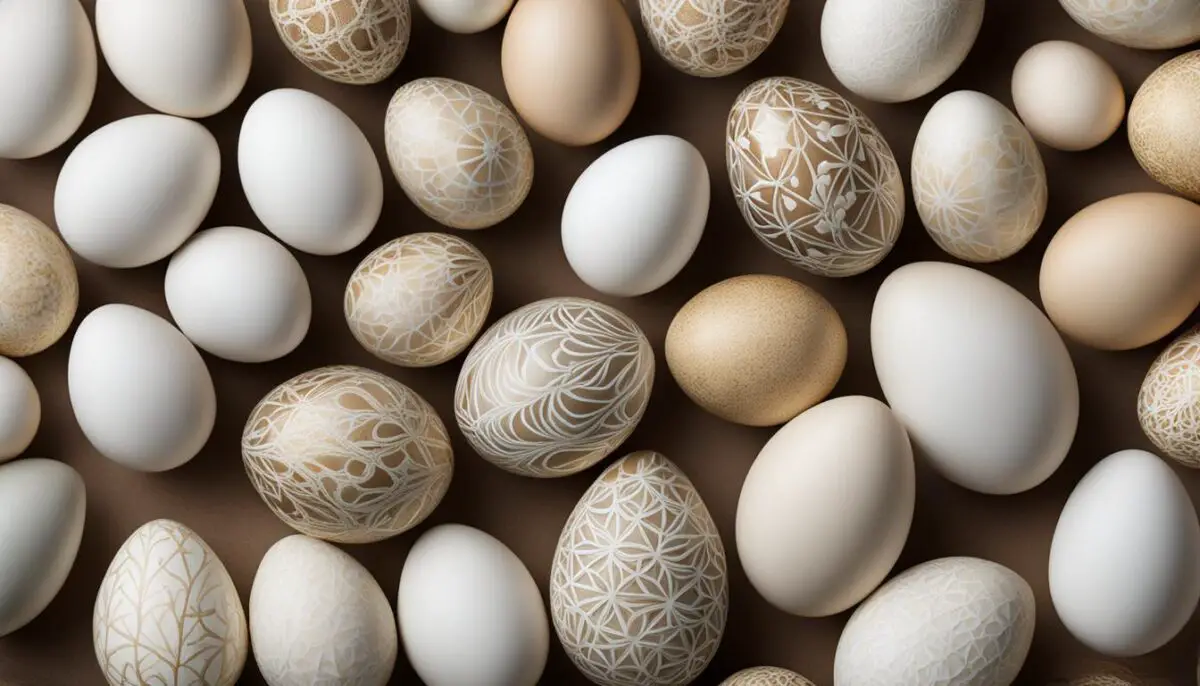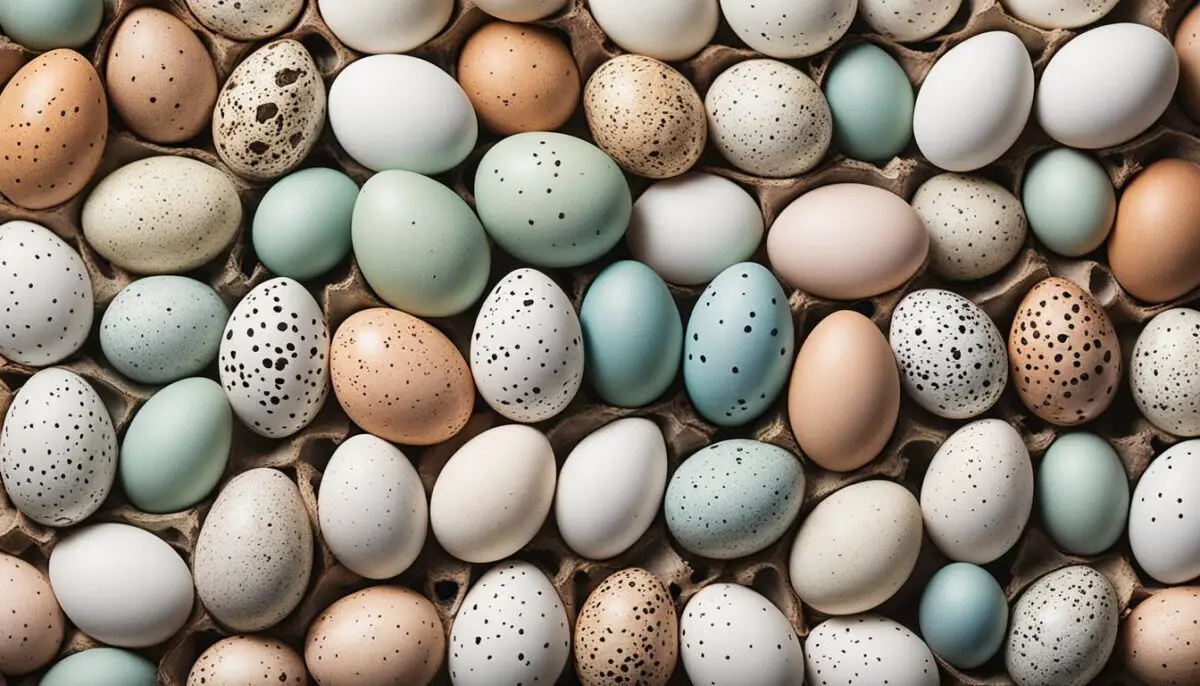Have you ever wondered what bird lays white eggs? Bird eggs come in all shapes, sizes, and colors, and white eggs are one of the intriguing variations. In this article, we will explore birds that lay white eggs and uncover fascinating facts about their nesting habits.
Key Takeaways:
- Various bird species lay white eggs, some with markings and some without.
- The size and shape of white bird eggs can provide clues to the bird’s identity.
- Hole-nesting birds often lay white or bluish-white eggs, while open nesters lay brown or speckled eggs.
- White egg markings can vary from pure white to delicate spotting patterns.
- Understanding bird egg characteristics can contribute to conservation efforts.
White Bird Egg Markings
When it comes to bird eggs, the default color is white, thanks to the calcium carbonate composition of their shells. However, not all bird species lay pure white eggs. Some birds lay white eggs with distinctive markings, adding intrigue to their appearance. Let’s explore the fascinating world of white bird egg markings.

While some bird species, like the Eurasian collared-dove and blue-throated hummingbird, lay pure white eggs with no markings, others exhibit more intricate designs. For example, the American kestrel and house sparrow lay white eggs adorned with unique patterns or spots.
Example: American Kestrel
“The American kestrel, scientifically known as Falco sparverius, is a small falcon that lays white eggs with reddish-brown speckles. These speckles provide effective camouflage, blending in with the rocky cliffs where these birds often nest.”
Example: House Sparrow
“House sparrows, scientifically known as Passer domesticus, lay white eggs with speckles appearing in various colors, such as gray, black, and brown. These markings are unique to each individual, creating beautiful and distinct patterns on their eggs.”
The markings on white bird eggs not only contribute to their aesthetics but also serve as an adaptation to their nesting environments. These distinctive patterns can offer camouflage or help attract mates.
| Bird Species | Egg Color | Markings |
|---|---|---|
| Eurasian Collared-Dove | White | None |
| Blue-Throated Hummingbird | White | None |
| American Kestrel | White | Reddish-brown speckles |
| House Sparrow | White | Speckles in gray, black, and brown |
White Bird Egg Size and Shape
The size and shape of white bird eggs can vary greatly among species. Generally, the bigger the bird, the bigger the egg. For example, the California condor lays the largest eggs of any U.S. bird species, measuring about 4.3 inches long. On the other end of the spectrum, hummingbirds lay eggs as small as half an inch.
Egg shapes also display considerable diversity, adding to the intrigue and beauty of avian reproduction. While some bird eggs are oval-shaped, resembling classic hen’s eggs, others have more distinct forms. Some eggs are globelike, perfectly spherical in shape. Others take on a raindrop-like appearance, with a rounded bottom and a pointed top. There are also pear-shaped eggs, narrow at one end and broader at the other, often with a pointed end.
In a world where the variety of species is astonishing, the size and shape of white bird eggs are mesmerizing manifestations of nature’s creativity. Let’s explore further with a visual representation:

| Bird Species | Egg Size | Egg Shape |
|---|---|---|
| California Condor | Approximately 4.3 inches long | Oval |
| Hummingbird | Approximately 0.5 inches long | Oval |
| Chicken | Approximately 2.5 inches long | Oval |
| Ostrich | Approximately 6 inches long | Globelike |
| Toucan | Approximately 2 inches long | Raindrop-shaped |
| Emu | Approximately 3 inches long | Pear-shaped |
White Bird Egg Nest
When it comes to white bird eggs, the type of nest can provide valuable insights into the bird’s nesting behavior. Hole-nesting birds, such as woodpeckers and owls, typically lay their eggs in cavities. These nests usually contain white or bluish-white eggs that help the parent birds easily locate them within the dark recesses of the nest.
On the other hand, birds that lay their eggs in open areas or on the ground, like plovers and gulls, have different nesting strategies. To protect their eggs from predators, these birds often lay well-camouflaged brown or speckled eggs that blend seamlessly into the surrounding environment.
Understanding the nest types of birds that lay white eggs can provide valuable information about their habitat preferences and nesting habits. It also emphasizes the importance of conserving suitable nesting sites for these birds to ensure the survival of future generations.

Birds and their Nest Types
| Bird Species | Nest Type |
|---|---|
| Woodpeckers | Hole Nest |
| Owls | Hole Nest |
| Plovers | Ground Nest |
| Gulls | Ground Nest |
Distinctive Characteristics of Bird Eggs
Bird eggs are fascinating in their variety of color, size, and shape. These distinctive characteristics offer valuable insights into the nesting behavior and identity of different bird species.
Egg Color and Nesting Behavior
The color of bird eggs often corresponds to their nesting behavior. While white eggs are common among cavity nesters, colored eggs are more frequently observed among ground nesters.
“The color of bird eggs often corresponds to their nesting behavior.”
For example, birds that nest in tree cavities, like woodpeckers and owls, typically lay white eggs. The white color makes it easier for parent birds to locate their eggs inside the dark cavities. On the other hand, birds that build nests on the ground, such as plovers and gulls, tend to lay camouflaged brown or speckled eggs for better protection against predators.
Egg Size and Bird Size
The size of bird eggs can also provide clues about the bird’s identity. As a general rule, larger birds lay larger eggs. The California condor, one of the largest bird species in the United States, lays eggs that measure about 4.3 inches long.
“As a general rule, larger birds lay larger eggs.”
Egg Development: Precocial vs. Altricial
Another fascinating characteristic of bird eggs is the development of the chicks inside. Some bird species hatch fully developed, with feathers and open eyes, known as precocial birds. In contrast, others hatch naked and helpless, requiring extensive parental care, and are classified as altricial birds.
| Bird Development | Examples of Bird Species |
|---|---|
| Precocial | Galliformes (chickens, quails), waterfowl (ducks, geese) |
| Altricial | Passeriformes (songbirds), raptors (hawks, eagles) |
“Some bird species hatch fully developed, with feathers and open eyes, known as precocial birds.”
Distinctive Characteristics in Bird Eggs
Understanding the distinctive characteristics of bird eggs, such as their color, size, and developmental patterns, enhances our knowledge of different bird species and their nesting behaviors.
Let’s take a moment to appreciate the beauty and diversity of bird eggs:

| Characteristic | Description |
|---|---|
| Color | Varies from pure white to a range of colors, including blue, green, and brown |
| Size | Varies based on bird size, with larger birds generally laying larger eggs |
| Shape | Varies from oval to globelike, raindrop-shaped, or pear-shaped with a pointed end |
| Development | Precocial (fully developed at hatch) or altricial (dependent on parental care) |
As we explore the world of bird eggs, we gain not only a deeper appreciation for the natural wonders around us, but also valuable insights into avian life and conservation efforts.
Birds That Lay White Eggs: Species Examples
Various bird species are known for laying white eggs. Let’s explore some examples:
American Robin
The American robin lays spotless, bright blue-green eggs. These vibrant eggs add a splash of color among the foliage, making them stand out.
Yellow Warbler
Yellow warblers lay pale bluish-gray eggs with delicate spotting patterns. The intricate marks on their eggs add a touch of charm to their nests.
Blue Jay
Blue jays lay eggs with small reddish-brown spots. The contrasting spots on their white eggs create a visually appealing pattern.
Northern Cardinal
Northern cardinals lay beige eggs with brown spots. These distinct markings give their eggs a unique appearance, blending in with their natural surroundings.
Cedar Waxwing
Cedar waxwings lay pale bluish-gray eggs. The soft color of these eggs adds an elegant touch to their nests.
Oriole
Orioles lay pale gray-blue eggs with lines and squiggles. The intricate designs on their eggs make them truly captivating.
To get a better visual understanding, take a look at this image below:
These are just a few examples of bird species that lay white eggs. Each species showcases its own unique markings and patterns, adding beauty and intrigue to our avian world.
Conclusion
White bird eggs can be found in a diverse range of bird species, each exhibiting unique nesting behaviors. By observing the color, size, and shape of the eggs, we can gain valuable insights into the identity and nesting habits of these birds. This knowledge not only helps in identifying birds that lay white eggs but also contributes to their conservation efforts.
Understanding the nesting behaviors of white egg-laying birds is crucial for their protection and preservation. By studying their nesting habits, we can create suitable environments to support their reproduction and survival. For example, hole-nesting birds like woodpeckers and owls rely on cavities for their nests, and the color of their white or bluish-white eggs aids in their location inside these dark spaces.
On the other hand, birds that lay their eggs in the open and on the ground, such as plovers and gulls, have evolved to lay well-camouflaged brown or speckled eggs. This adaptation helps protect their eggs from predators by blending in with their surroundings. Recognizing these nesting behaviors allows us to appreciate the diversity and complexity of bird reproduction and contributes to their long-term conservation.
FAQ
What are some birds that lay white eggs?
Some bird species that lay white eggs include the Eurasian collared-dove, blue-throated hummingbird, American kestrel, and house sparrow.
Do all bird species lay pure white eggs?
No, not all bird species lay pure white eggs. Some birds lay white eggs with markings, while others lay eggs in different colors.
How can I identify white bird eggs?
To identify white bird eggs, you can look at their markings, size and shape, and where they are laid. Pure white eggs with no markings are usually laid by certain bird species.
What factors determine the size and shape of white bird eggs?
The size and shape of white bird eggs can vary among species. Generally, the bigger the bird, the bigger the egg. Egg shapes can be oval, globelike, raindrop-shaped, or pear-shaped with a pointed end.
Why are some bird eggs white and others colored?
The color of bird eggs often correlates with nesting behavior. Birds that nest in cavities tend to lay white eggs, while birds that nest on the ground or in open areas lay colored eggs to provide camouflage.
Can you give examples of bird species that lay white eggs with markings?
Some examples of bird species that lay white eggs with markings include the American robin, yellow warbler, blue jay, northern cardinal, cedar waxwing, and oriole.
What can understanding bird eggs’ characteristics contribute to?
Understanding the characteristics of bird eggs, such as color, size, and shape, can help identify the birds that lay white eggs and contribute to their conservation efforts.

